
|
Letter from Philadelphia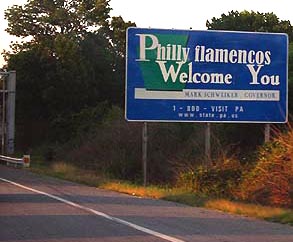 (Tuesday
June 25, 2002) I couldn't
believe my eyes as Steve Svoboda and I sped down I-95 running late
for the Philadelphia Juerga last Friday. I swear, the sign said "Philly
flamencos welcome you" (see photo). Then again, I could've been hallucinating
due to lack of sleep (mainly from websurfing late at night researching
Criptogramas). (Tuesday
June 25, 2002) I couldn't
believe my eyes as Steve Svoboda and I sped down I-95 running late
for the Philadelphia Juerga last Friday. I swear, the sign said "Philly
flamencos welcome you" (see photo). Then again, I could've been hallucinating
due to lack of sleep (mainly from websurfing late at night researching
Criptogramas).
It was a bit of an adventure. Of all people, yours truly should know
by heart, the details of everything going in the DC area and
beyond. But noooooo! We hopped in the car at 4pm-ish, waded through
the sea of traffic on our beloved 495, got onto 95 north and followed
the signs for Philadelphia, missed an exit, took a (scenic) detour through
Delaware. I figured that once we got into the city I could just call
Philly flamencos Anna and Tito Rubio on their cellphone and get directions.
And sure enough they did! What I would like to say about the Juerga for your readers is this:
We decided to organize this juerga for two reasons, one was to raise
scholarship money for the students of the AMLA Latin School of the Arts. We think guitarist Shirley Martin summed it up the best way, when she called us to ask about the juerga, all she wanted to know was "Can I play my guitar, because all I care about is playing my guitar!" We say "Olé, Shirley!" Thank you Miguelito, for all you do to support Flamencos everywhere! Un beso muy fuerte de Anna y Tito Rubio" [Editor's note: with today's technology it's easy to forge just about anything. The photo at the top of this article was based on an actual photograph of a Pennsylvania roadsign. Yours truly, using Adobe Photoshop, changed Pennsylvania to "Philly flamencos."] Hola Miguelito, I just wanted to thank you again for coming all the way to Philly to participate in the Juerga. Anna and Tito Rubio are wonderful people, and I find it very inspiring to see them work so hard to bring all the Philly Flamencos together. It is truly amazing what a small world this really is--and sometimes the internet helps remind me of this. For example, I found out about Tito and Anna (Philadelphia, PA) through Bianca Antonia's website (Houston, TX), which I believe Anna discovered through your website (Washington, DC). Anna was in contact with Bianca Antonia, who posted Anna and Tito's full biographies on her website. I found their bios on Bianca Antonia's website and then got in touch with Tito for Flamenco Guitar lessons! And to top it off, Bianca Antonia performs along with Teye & Viva El Flamenco in Texas. Teye is from Austin, TX and he is the one who sold me my Flamenco Guitar (which came from Sevilla, Spain!!!). By the way, here's the info from the label inside the Triana:
"Triana" Thanks again Miguelito for all of your enthusiasm and support!! It was a pleasure to meet both you and Steve (Svoboda)!!
Greetings y Viva Flamenco!!!
When I arrived at the front entrance, the doors were locked and the theatre was dark. Disappointed, I asked the two young ladies sitting nearby, "What time did the show finish?" "Around ten o'clock," one of the replied. It was already 10:30pm.
Enough time for the artists to quickly pack up and head to the nearest
restaurant for an after-concert dinner. I paused for a moment, then realized that I had met this young lady before. I remember taking her picture at the Pre-Feria party in 2000. It was "Isabelita" Otero (right) and her sister Marcela (center). Years ago, I frequently performed with their mother, Isabel (left), in a group called "Triana." In 1996, we performed at Mary Washington College's International Festival in Fredericksburg, Virginia. Back then, I would frequently go to Isabel's house to rehearse. "Isabelita" and Marcela were still in high school at the time.
NOCHE FLAMENCA
Dancers
Guitarists
Singers
When I asked them about their favorite part of the concert, "Isabelita" said she was on the "edge of her seat" when Soledad Barrio performed her "Soleá." She dance it with so much "passion." Isabel especially enjoyed Elena Martín's "Siguiriyas" saying it was "muy especial." Unfortunately, I didn't have time to get a more detailed review--I had to catch the last train home for the evening. But, if you would like to publish your own review of last night's concert, please post it on my message board. For more information about the Noche Flamenca tour, visit their official website. My thanks to the Otero family for making it worth the trip! [Editor's note: following in her mother's footsteps,
"Isabelita" will soon be taking flamenco dance classes with Ana Martinez.
Actually "Isabelita's" name is really Isabel, just like her mom. For
my convenience, I decided make use of the name "Isabelita" instead of
repeatedly saying "Isabel Otero's older daughter who's also named Isabel."]
I studied it all: theory, history, composition, form and analysis etc. Some of what I learned back in college, especially in "Conducting 101," I still use everyday. Yeah, that's right. Yours truly spent a semester learning how to wave a baton to communicate information to musicians, telling them what to do. So how does conducting apply to flamenco? Here's another question. Have you ever seen a guitarist and a dancer somehow magically come in together on first beat without vocally counting or or giving other audio cues? How is this done? Think of the dancer as a conductor, the guitarist
as the orchestra and the dancer's feet as the conductor's baton. With me so far? OK, as you know, in flamenco, the guitarist follows the dancer. So it's the dancer's responsibility to communicate information to the guitarist telling him what to do. Let's say the dancer is about to begin a footwork section. Chances are she is not going to look at the guitarist and say "Ready? 1, 2, 3!" Instead, the guitarist can determine the tempo by observing the preparation
of the first step as the dancer brings the foot back (see photo above).
The speed of the preparation tells the guitarist the speed of the first step
(see second photo). Now that the guitarist knows the tempo, the dancer brings her foot down for the execution, "BANG!" and the music comes in on the beat and at the right tempo together with the dancer. "Being the conductor" and "following the conductor" are skills that take time to learn. But the benefit is that dancer and guitarist can be more spontaneous using whatever tempo suits the mood of the moment. Please bear in mind that the above "conductor" concept does NOT apply to ALL situations. This is just one of many ideas to help my fellow flamenco dance accompaniment students. (My thanks to flamenco dancer Grace for posing for these photos.)
|
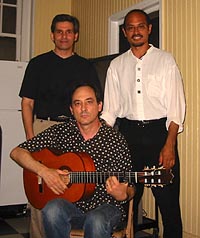 So
we arrived (late). The juerga took place at the Asociación de Músicos
Latino Americanos. We walked in right after the first
jam session had finished. I had the pleasure of finally meeting in person my longtime email penpals guitarists Pat D'Aprile and Tito Rubio. Three states are represented here: Pat came from New Jersey, Tito's based in Pennsylvania and yours truly from DC (sort of a state).
So
we arrived (late). The juerga took place at the Asociación de Músicos
Latino Americanos. We walked in right after the first
jam session had finished. I had the pleasure of finally meeting in person my longtime email penpals guitarists Pat D'Aprile and Tito Rubio. Three states are represented here: Pat came from New Jersey, Tito's based in Pennsylvania and yours truly from DC (sort of a state). 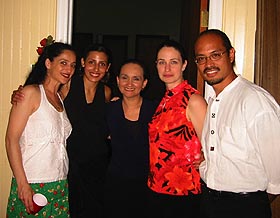 Next, I met some of the dancers who were performing that night. From the left: Anna Rubio, Mariah (originally from Albuquerque), Bernadette Gaxiola (yeah, she's related to
Next, I met some of the dancers who were performing that night. From the left: Anna Rubio, Mariah (originally from Albuquerque), Bernadette Gaxiola (yeah, she's related to 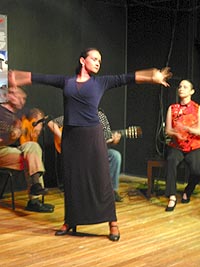 "We want to thank you and Steve so much for coming up to Philly for
our juerga Friday (and for bringing your guitar and joining us!). It really
made us feel good to have your support and it helped validate our idea
that we Flamencos have to stick together and support each other!
"We want to thank you and Steve so much for coming up to Philly for
our juerga Friday (and for bringing your guitar and joining us!). It really
made us feel good to have your support and it helped validate our idea
that we Flamencos have to stick together and support each other!
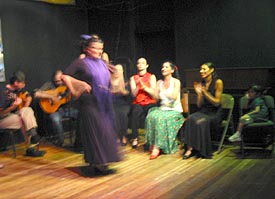 But what really inspired us to try to get everyone together was
to try to overcome the feelings of separation and competition that often
develop in the Flamenco world here in the U.S.
But what really inspired us to try to get everyone together was
to try to overcome the feelings of separation and competition that often
develop in the Flamenco world here in the U.S.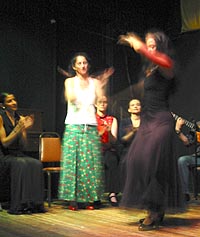 What
we did was call and write to EVERYONE involved in Flamenco in Philadelphia
and invite them to join us to celebrate the joy we all feel performing
Flamenco and to help raise money for deserving kids. We invited everyone
to advertise their classes to everyone. We believe only by working together
and being together can we raise the level of Flamenco here in Philly
to increase the demand for performers to come here and create a pool
of students to allow us to bring guest teachers we can all benefit from.
In our opinion, even though Flamenco is definitely an individual
art form, it is also definitely a group experience!
What
we did was call and write to EVERYONE involved in Flamenco in Philadelphia
and invite them to join us to celebrate the joy we all feel performing
Flamenco and to help raise money for deserving kids. We invited everyone
to advertise their classes to everyone. We believe only by working together
and being together can we raise the level of Flamenco here in Philly
to increase the demand for performers to come here and create a pool
of students to allow us to bring guest teachers we can all benefit from.
In our opinion, even though Flamenco is definitely an individual
art form, it is also definitely a group experience!
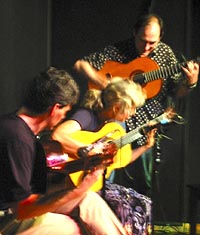 Some
people were not able to participate, and some people were not willing,
but those of us who did participate had a great time, and the people
who came just to watch had a great time, too. It didn't matter that
most of us had not been on a stage together in years (or ever), that
we weren't familiar with each other's material, that we had no singer
and that no one was getting paid, all that mattered was we were enjoying
Flamenco for Flamenco's sake!
Some
people were not able to participate, and some people were not willing,
but those of us who did participate had a great time, and the people
who came just to watch had a great time, too. It didn't matter that
most of us had not been on a stage together in years (or ever), that
we weren't familiar with each other's material, that we had no singer
and that no one was getting paid, all that mattered was we were enjoying
Flamenco for Flamenco's sake!
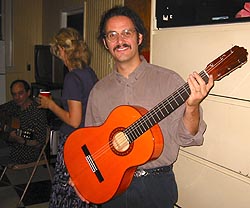 John Gaspari (see photo) from Philadelphia writes:
John Gaspari (see photo) from Philadelphia writes: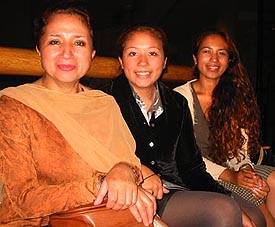 "Hey, I know you. You're Miguelito."
"Hey, I know you. You're Miguelito."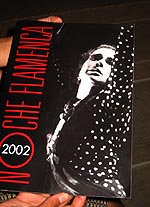 So...to
make a long story short, all was not lost. I arrived too late for the
concert, but I got to get reaquainted with some old friends. AND, "Isabelita"
happened to have a concert program:
So...to
make a long story short, all was not lost. I arrived too late for the
concert, but I got to get reaquainted with some old friends. AND, "Isabelita"
happened to have a concert program: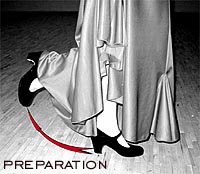
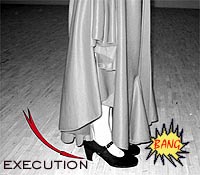 Just as an orchestral conductor can communicate the tempo by raising
the baton in preparation for the first beat, the dancer can communicate
to the guitarist the tempo of the footwork section by raising her foot
in preparation of the first step.
Just as an orchestral conductor can communicate the tempo by raising
the baton in preparation for the first beat, the dancer can communicate
to the guitarist the tempo of the footwork section by raising her foot
in preparation of the first step.